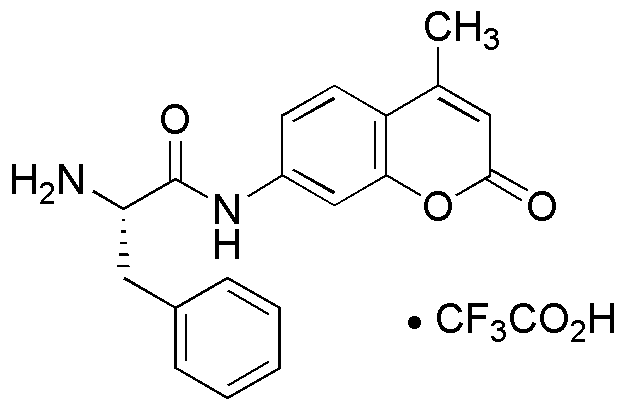L-Phenylalanine 7-amido-4-methylcoumarin trifluoroacetate is widely utilized in research focused on:
- Fluorescent Probes: This compound is used to create fluorescent probes for studying protein interactions and cellular processes, providing researchers with valuable insights into biological mechanisms.
- Biochemical Assays: It serves as a substrate in various enzyme assays, allowing scientists to measure enzyme activity and understand metabolic pathways more effectively.
- Drug Development: The compound is explored in pharmaceutical research for its potential therapeutic applications, particularly in designing drugs that target specific biological pathways.
- Peptide Synthesis: It is utilized in peptide synthesis, enabling the production of custom peptides for research and therapeutic purposes, which can be tailored to specific biological functions.
- Fluorescence Microscopy: This chemical is applied in fluorescence microscopy techniques, enhancing imaging capabilities in cellular biology studies and improving visualization of cellular structures.
General Information
Properties
Safety and Regulations
Applications
L-Phenylalanine 7-amido-4-methylcoumarin trifluoroacetate is widely utilized in research focused on:
- Fluorescent Probes: This compound is used to create fluorescent probes for studying protein interactions and cellular processes, providing researchers with valuable insights into biological mechanisms.
- Biochemical Assays: It serves as a substrate in various enzyme assays, allowing scientists to measure enzyme activity and understand metabolic pathways more effectively.
- Drug Development: The compound is explored in pharmaceutical research for its potential therapeutic applications, particularly in designing drugs that target specific biological pathways.
- Peptide Synthesis: It is utilized in peptide synthesis, enabling the production of custom peptides for research and therapeutic purposes, which can be tailored to specific biological functions.
- Fluorescence Microscopy: This chemical is applied in fluorescence microscopy techniques, enhancing imaging capabilities in cellular biology studies and improving visualization of cellular structures.
Documents
Safety Data Sheets (SDS)
The SDS provides comprehensive safety information on handling, storage, and disposal of the product.
Product Specification (PS)
The PS provides a comprehensive breakdown of the product’s properties, including chemical composition, physical state, purity, and storage requirements. It also details acceptable quality ranges and the product's intended applications.
Certificates of Analysis (COA)
Search for Certificates of Analysis (COA) by entering the products Lot Number. Lot and Batch Numbers can be found on a product’s label following the words ‘Lot’ or ‘Batch’.
Número de catálogo
Número de lote/lote
Certificates Of Origin (COO)
This COO confirms the country where the product was manufactured, and also details the materials and components used in it and whether it is derived from natural, synthetic, or other specific sources. This certificate may be required for customs, trade, and regulatory compliance.
Número de catálogo
Número de lote/lote
Safety Data Sheets (SDS)
The SDS provides comprehensive safety information on handling, storage, and disposal of the product.
DownloadProduct Specification (PS)
The PS provides a comprehensive breakdown of the product’s properties, including chemical composition, physical state, purity, and storage requirements. It also details acceptable quality ranges and the product's intended applications.
DownloadCertificates of Analysis (COA)
Search for Certificates of Analysis (COA) by entering the products Lot Number. Lot and Batch Numbers can be found on a product’s label following the words ‘Lot’ or ‘Batch’.
Número de catálogo
Número de lote/lote
Certificates Of Origin (COO)
This COO confirms the country where the product was manufactured, and also details the materials and components used in it and whether it is derived from natural, synthetic, or other specific sources. This certificate may be required for customs, trade, and regulatory compliance.


